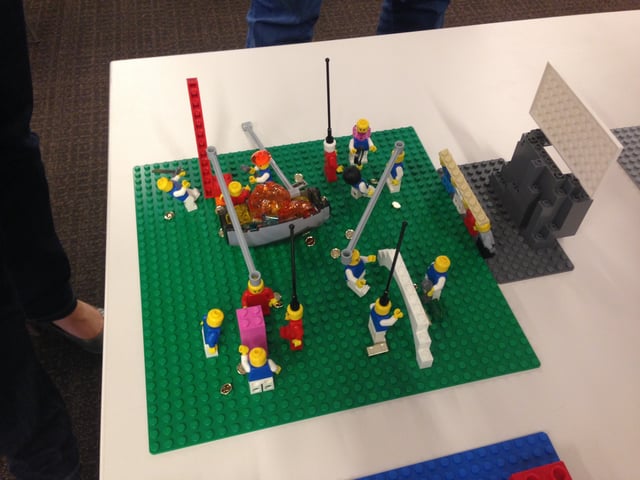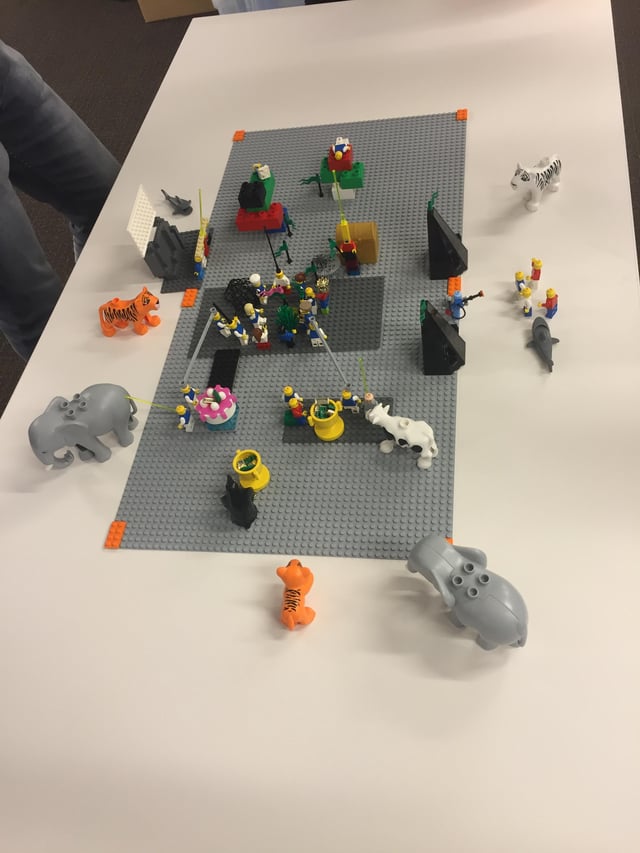
Last month I organized an explorative Lego Serious Play session at our offices. The goal was to get to know the technique and to learn more about the pros and cons of where the practice can be applied. Read on to find how it went about.
“Look at them, playing with Lego. What do they hope to achieve?!”
“So now is playing with Lego going to solve REAL issues? Yeah, right!”
“Come on, some of us have to work around here! What child’s play!”
Okay, maybe our colleagues weren’t that harsh, but some of them certainly were thinking parts of these quotes. Even the participants were very skeptical when our Lego Serious Play session started. And who could blame them? Imagine yourself solving your greatest organizational issues by using Lego. Hard to fathom, isn’t it?
And yet LSP works. For two reasons: visualization and storytelling.
Visualization is a proven technique that is not only used by Lego, but that also helps you remember. Building models using Lego clearly visualizes them for every participant in the workshop and helps them understand what the builder is telling. As such, it’s much easier to remember what was told.
The power of Lego constructions is that they allow you to make a connection between different views when the individual structures are combined. This way you can create a shared model that represents the solution to a problem.
Storytelling makes sure that everyone understands what is meant by the creation. The basis is that you can build anything you like, but the story you tell makes it the thing you want it to be. When building a model everyone will be able to tell their own story about the creation, but only you know what it really is supposed to be. That’s why the storytelling part cannot be skipped.
For an LSP workshop to be successful, it’s important that everyone participates, and this practice enables that. It also prevents potential hijackers of your workshop, i.e. the loudest participant, to force their view on the subject at hand.
A shortcoming of this practice is that people who weren’t present when the model was built and didn’t hear all the background stories have a hard time understanding what the model represents.
That's why we videotaped our LSP session. Now we can revisit that moment and explain to others what we meant with our construction. The technique also requires the right soft skills. You can’t just build and explain. You need to actively and critically listen to what other participants have to say, because interaction is key in this kind of workshop.
A factor that is not to be underestimated is the presence of an excellent facilitator. There are various ways to tackle different issues within your company. It’s the facilitator’s job to interpret what the issue, as formulated by a client, actually means. Then they have to analyze what is expected as the outcome of the session and how the participants should arrive at this destination. That’s why at AE we invited Marc Sonnaert from The Duck Academy. Marc and his colleagues are certified Lego Serious Play facilitators and have already helped many companies solve different types of issues.
Lessons learned
- Prepare a well-defined scope so the facilitator can find the best approach
- Keep in mind that there are different steps depending on the defined scope
- Ask open-ended questions
- Take pictures and film the session
- If possible, display the final model in your offices
Here are some pictures of our workshop to get a more visual image of what is going on at a Lego Serious Play session:




When you're planning on using a workshop in your organization do consider Lego Serious Play. The possibilities are endless: defining new business, (re)designing business services, customer journeys ...
At AE, we offer various types of workshops. Get in touch if you have problems with selecting the right type of workshop for your goals or need help facilitating one. We’ll gladly help you out!
Header image credit: Lewis Tse Pui Lung / Shutterstock.com
/social-suggested-images/legoseriousplay_hdr.jpg?width=583&height=366&name=legoseriousplay_hdr.jpg)




